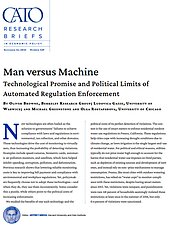New technologies are often hailed as the solution to governments’ failures to achieve compliance with laws and regulations in environmental, tax collection, and other domains. These technologies drive the cost of monitoring to virtually zero, thus increasing the probability of detecting violations. Examples include speed cameras, biometric cards, automatic air pollution monitors, and satellites, which have helped inhibit speeding, corruption, pollution, and deforestation. Previous research shows that lowering reliable monitoring costs is key to improving bill payment and compliance with environmental and workplace regulations. Yet, policymakers frequently choose not to adopt these technologies—and when they do, they use them inconsistently. Some consider this a puzzle, while others point to the political costs of increasing enforcement.
We studied the benefits of one such technology and the political costs of its perfect detection of violations. The context is the use of smart meters to enforce residential outdoor water use regulations in Fresno, California. These regulations help cities cope with increasing drought conditions due to climate change, as lawn irrigation is the single largest end-use of residential water. For political and ethical reasons, utilities typically do not price water high enough to account for the harms that residential water use imposes on third parties, such as depletion of existing sources and development of new ones, and instead rely on non–price mechanisms to manage consumption. Fresno, like most cities with outdoor watering restrictions, has relied on “water cops” to monitor compliance with these restrictions, despite having smart meters since 2013. Yet, violations were rampant, and punishments were rare: 68 percent of households seemingly violated these restrictions at least once in the summer of 2016, but only 0.4 percent of violations were sanctioned.
We implemented a randomized field experiment with nearly 100,000 Fresno households, introducing automated enforcement of outdoor water use restrictions via smart meters that enabled perfect detection of violations. Fresno was one of the first large municipal water utilities with universal smart meter adoption among single-family residential customers. We collaborated closely with the city to design and implement an evaluation that experimentally varied both the enforcement method—whether households were newly subject to automated enforcement via smart meters or continued the status quo of in-person inspections by water cops (i.e., detection rates of 100 percent versus 0.4 percent)—and the magnitude of the fines that violating households faced. For households in the automated group, the experiment also varied the excessive water use threshold that triggers warnings and fines. This is the threshold above which households are presumed to be using water outdoors and thus subject to the restrictions. The experiment took place between July and September 2018 during peak outdoor watering season. We measured effects both on water use and compliance using continuous smart meter data and on the political fallout using call data. To estimate the latter, we collected information on customer phone calls to the city’s Department of Public Utilities.
The experiment provided an unprecedented opportunity to vary the key parameters that determine the cost of committing a crime—probability of detection and penalty— and empirically estimate the effects of these parameters on violations and backlash against the program. We reveal three primary findings. First, automation greatly increased enforcement and compliance with the law. While the share of households fined for noncompliance grew from 0.1 to 14.3 percent due to improved detection, the improved enforcement reduced violations by 17 percent and the number of violating households by 8 percent per month. Second, automated enforcement decreased summer water consumption by about 3 percent. If scaled citywide, the three-month experiment would have achieved 20 percent of the annual reductions in residential water use that Governor Gavin Newsom requested of California residents on July 8, 2021, in response to another drought. Smart meters also reduced water consumption after the experiment ended, suggesting even larger persistent conservation effects. Third, automated enforcement created political backlash that ultimately led to the pilot’s termination, as the number of households calling the utility department increased by 654 percent and calls identifiable as complaints and disputes of enforcement actions increased by 1,102 percent.
There are several other findings. Lower fines did not affect the frequency of violations, water consumption, or customer complaints. Moreover, the percentage effect of automated enforcement on water conservation was roughly constant across the distributions of income and prior water consumption. However, the wealthy and heavy water users complained more frequently. Finally, warnings and fines caused immediate reductions in water consumption and increases in customer complaints. Together, these findings show that households understood the mechanics of automated enforcement and adjusted their behavior accordingly.
Yet, despite attempts to be customer-friendly (e.g., grace periods implicit in the fine schedule), the automated enforcement program did not survive. Public backlash, including customer calls, led the city to implement a fine moratorium, weaken the conservation rules, and finally institute new rules that essentially outlawed automated enforcement of violations. In practice, the city returned to relying on water cops’ inspections. This experience serves as a cautionary tale about the limits of new technologies to solve compliance problems and underscores the need for research to identify the settings where they can succeed.
NOTE
This research brief is based on Oliver R. Browne et al., “Man vs. Machine: Technological Promise and Political Limits of Automated Regulation Enforcement,” Review of Economics and Statistics (March 15, 2023): 1–36.

This work is licensed under a Creative Commons Attribution-NonCommercial-ShareAlike 4.0 International License.
